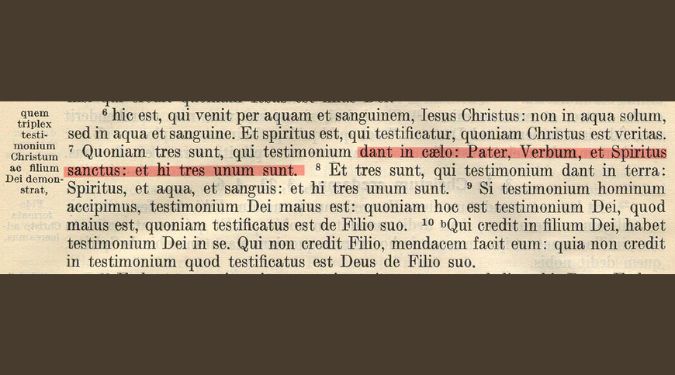The Jews then said to him, “You are not yet fifty years old, and have you seen Abraham?” Jesus said to them, “Truly, truly, I say to you, before Abraham was, I am.” So they took up stones to throw at him; but Jesus hid himself, and went out of the temple.
John 8:57-59 RSV
I AM
The Church noticed long ago that St. John remarkably captures Jesus using the phrase “I am”, either with a predicate noun or without, twenty-three times, almost twice as many times as the other three gospels combined, in any context.
The Koine Greek phrase that St. John uses in his gospel is ἐγὼ εἰμί, which can be transliterated as “ego eimi” and is pronounced, “egg-O eye-MEE”. The verb used in this phrase, εἰμί, is the first person singular, present tense, indicative form of the Koine Greek verb “to be.” When not used with a predicate, as it is on the lips of Jesus in the Gospel of John ten times, the phrase can mean, “I am”, “I am he”, or “It is I”.
You probably can recall some of the instances of Jesus’ use of this phrase with a predicate noun: “I am the Bread of Life”, “I am the Light of the World”, “I am the Good Shepherd”, and “I am the Way, the Truth and the Life”, to mention a few.
But this first person use of the phrase, “I am” in John 8:58, shown above, sounds jarring, does it not? You’d expect Jesus to say, “before Abraham was, I was” or something similar, and even that would be startling enough.
St. John Chrysostom (d. 407 AD), a Doctor of the Church and archbishop of Constantinople, explains:
But wherefore said He not, “Before Abraham was”, I was, instead of “I Am”? As the Father uses this expression, “I Am”, so also does Christ; for it signifies continuous Being, irrespective of all time. On which account the expression seemed to them to be blasphemous. Now if they could not bear the comparison with Abraham, although this was but a trifling one, had He continually made Himself equal to the Father, would they ever have ceased casting stones at Him?
John Chrysostom, Homilies on the Gospel of John, Homily 55
St. John Chrysostom was referring to God revealing his Divine Name to Moses in the burning bush in the third chapter of the Book of Exodus. There we read:
Then Moses said to God, “If I come to the people of Israel and say to them, ‘The God of your fathers has sent me to you,’ and they ask me, ‘What is his name?’ what shall I say to them?” God said to Moses, “I AM WHO I AM.” And he said, “Say this to the people of Israel, ‘I AM has sent me to you. Then he added: This is what you will tell the Israelites: I AM has sent me to you.
Exodus 3:13-14 RSV
“I am” is a form of the verb, “to be”, and the name of God derived from these verses, יְהוָ֞ה, is represented over six thousand times in the Old Testament by four Hebrew consonants, Yud – Hay – Vuv – Hay, or transliterated into English, Y-H-W-H. Scholars have hypothesized that it’s a third person form of the verb, meaning either “He is”, “The One who is”, “He will be” or even the causative, “He causes to be”. Both Jews and Catholics hold this name to be ineffable, that is, not to be pronounced.
St. John Chrysostom’s contention that Jesus was making himself equal to the Father is bolstered by the fact that the audience wanted to stone him, which was the penalty for blasphemy according to the Mosaic Law:
He who blasphemes the name of the Lord shall be put to death; all the congregation shall stone him; the sojourner as well as the native, when he blasphemes the Name, shall be put to death.
Leviticus 24:16 RSV
I am He
Another way to translate ἐγὼ εἰμί into English is “I am he,” as we see here in the Gospel of John:
I told you that you would die in your sins, for you will die in your sins unless you believe that I am he.
John 8:24 RSV
And here:
So Jesus said, “When you have lifted up the Son of man, then you will know that I am he, and that I do nothing on my own authority but speak thus as the Father taught me.
John 8:28 RSV
And here:
I tell you this now, before it takes place, that when it does take place you may believe that I am he.
John 13:19 RSV
And in the Garden of Gethsemane:
Then Jesus, knowing all that was to befall him, came forward and said to them, “Whom do you seek?” They answered him, “Jesus of Nazareth.” Jesus said to them, “I am he.” Judas, who betrayed him, was standing with them. When he said to them, “I am he,” they drew back and fell to the ground.”
John 18:4-6
A skeptic might respond to this last example of “I am he” by saying that Jesus was merely identifying himself to the Temple posse. But look carefully at the last phrase: “they drew back and fell to the ground.” Falling and/or recoiling is often presented in the Sacred Scriptures as a response to recognizing the Divine Presence (Psalm 56:9, Daniel 10:9, Rev. 1:17).
“I [am] He” in Hebrew is, אֲנִי־ הֽוּא׃, which is transliterated “Ani Hu” and pronounced “an-EE hoo”. God uses this phrase nine times in the Hebrew Old Testament (Deut. 32:39, Is. 41:4; 43:10,13 ,25; 46:4; 48:12; 51:12; 52:6), and the Judeans would have been very familiar with these passages. Here are three examples:
Who has performed and done this, calling the generations from the beginning? I, the Lord, the first, and with the last; I am He.
Isaiah 41:4 RSV
“You are my witnesses,” says the Lord, “and my servant whom I have chosen, that you may know and believe me and understand that I am He. Before me no god was formed, nor shall there be any after me.
Isaiah 43:10 RSV
“‘See now that I, even I, am he, and there is no god beside me; I kill and I make alive; I wound and I heal; and there is none that can deliver out of my hand.
Deuteronomy. 32:39 RSV
In the Septuagint, the Greek Old Testament favored by the inspired authors of the New Testament, הֽוּא אֲנִי־ (Ani Hu) is translated ἐγὼ εἰμί, the phrase in John’s gospel that we’ve been discussing.
Pope Benedict XVI discussed this very phrase in his book, Jesus of Nazareth:
So what does it mean when Jesus says “I am he”? …At the great time of hope for a new Exodus at the end of the Babylonian exile, Deutero-Isaiah took up once again the message of the burning bush and developed it in a new direction: “‘You are my witnesses,’ says the LORD, ‘and my servant whom I have chosen, that you may know and believe me and understand that I am he. Before me no god was formed, nor shall there be any after me. I, I am YHWH, and besides me there is no savior’” (Is 43:10f.). “That you may know and believe me and understand that I am he”—the old formula ’ani YHWH is now abbreviated to ’ani hu’—“I he,” “I am he.” The “I am” has become more emphatic, and while it remains a mystery, it has also become clearer.
Pope Benedict XVI, Jesus of Nazareth: From the Baptism in the Jordan to the Transfiguration, pp. 346-347
Conclusion
“We are faced, then, with a frightening alternative. This man we’re talking about either was (and is) just what He said or else a lunatic, or something worse.”
C.S. Lewis, The Case for Christianity, p. 45
It is clear that Jesus, by appropriating the divine “I am” and “I am he” for himself, was clearly indicating his divinity. While this won’t shock or outrage 21st century Christians as it did his first century listeners, it does force us to make a decision. If He spoke the truth about Himself, then he is Lord, and if Lord, He deserves not only our worship, but our very lives.
Works Cited
Lewis, C. S. The Case for Christianity. Simon & Schuster, 1996.
Pope Benedict XVI, and Joseph Ratzinger. Jesus of Nazareth: From the Baptism in the Jordan to the Transfiguration. Translated by Adrian J. Walker, Crown Publishing Group, 2007.



